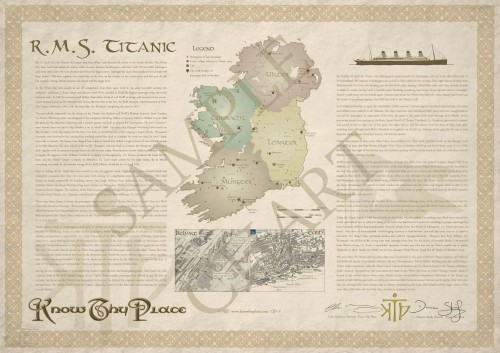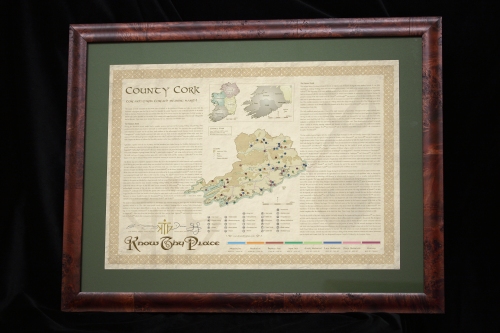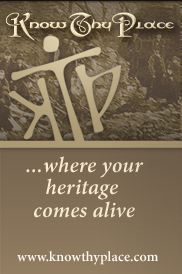After extensive research and hard graft from all the team at Know Thy Place, we are delighted to say that our R.M.S. Titanic Chart is now complete. It tells the story of the ill-fated luxury liner’s connections with Ireland in a unique and informative way. The centre-piece is a map of Ireland, marking the home places of 129 people from the island that our researchers identified as being lost. Know Thy Place Director Damian Shiels describes some of the intriguing details we found out.
The story of the Titanic’s connections with Ireland begins with the Harland & Wolff shipyard in Belfast, where she was designed and built. We explain her building with the aid of a Belfast docks map, showing the key sites associated with the White Star Liner. One of the interesting stories we were able to uncover was the involvement a number of Irish businesses had with the Titanic’s fit-out, such as William Liddell & Company from Co. Down who produced the linen for the vessel, and the Kildare Carpet Company in Co. Laois which made the state-room carpets.
A key part of the Titanic story is that of her last port of call, Queenstown (now Cobh). A total of 123 passengers embarked from here on the doomed ship, and we look at their journey from ‘Titanic Pier’ behind the James Scott and Company offices aboard the tenders that took them to the liner anchored off Roche’s Point. As with Belfast, a map of Cobh highlights a number of the key areas in the town associated with the Titanic’s brief visit.
The central part of the chart’s story looks at the Irish passengers and crew who were aboard the Titanic, telling some of their stories. We spent a long time trying to generate a comprehensive list of people from Ireland who were lost when the Titanic went down, as we discovered that many publications cite wildly different numbers in this regard. There are many reasons for this- some exclude Irish crew members from their totals, while others fail to include Northern Ireland in their calculations. We found the only solution was to create our own list of individuals specifically for the chart.
We eventually generated a list of 129 passengers and crew from the island who were lost, a number that was almost certainly higher as only scant details survive for many of the crew. For the first time, the cities, towns and townlands where these people were from were used to create an at a glance image of the human cost to Ireland of the ship’s sinking. This unique map allows you to see which parts of the island were most affected, and brings home the scale and range of the impact that the loss of the Titanic must have had. For anyone interested in the Titanic Chart you can find order it direct from our website by clicking here.










